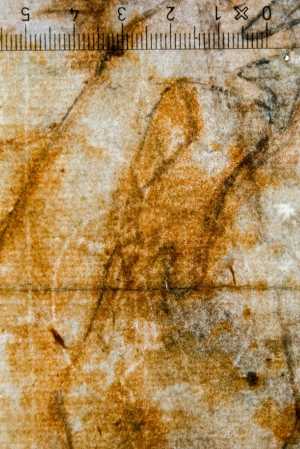Specifications
| Title | Cain Slaying Abel |
|---|---|
| Material and technique | Black chalk, red chalk, heightened with white, pen and black ink, blue-grey wash, incised |
| Object type |
Drawing
> Two-dimensional object
> Art object
|
| Location | This object is in storage |
| Dimensions |
Height 372 mm Width 240 mm |
|---|---|
| Artists |
Circle of:
Francesco Morandini (il Poppi)
Previously attributed: Palma Giovane (Jacopo Negretti) |
| Accession number | I 264 (PK) |
| Credits | Loan Stichting Museum Boijmans Van Beuningen (former Koenigs collection), 1940 |
| Department | Drawings & Prints |
| Acquisition date | 1940 |
| Creation date | in circa 1550-1600 |
| Watermark | Circle with unidentified figure (horseman?) and something on top (star?) (69 x 43 mm, upside down, centre, on P4 of 7P, vH) |
| Inscriptions | 'Michelangelo' (lower left, pen and brown ink, cut off), 'Michelangelo' (verso, lower right, pen and brown ink), '70' (verso, lower right, pen and brown ink) |
| Collector | Collector / Franz Koenigs |
| Mark | F.W. Koenigs (L.1023a deest) |
| Provenance | (?) Sir Thomas Lawrence (1769-1830, L.2445 deest), London; (?) Art dealer Samuel Woodburn, acquired with the Lawrence Collection in 1834; - ; Franz W. Koenigs (1881-1941, L.1023a), Haarlem, acquired in 1928 (Roman, first half 16th century); D.G. van Beuningen (1877-1955), Rotterdam, acquired with the Koenigs Collection in 1940 and donated to Stichting Museum Boijmans Van Beuningen |
| Exhibitions | Rotterdam 2009 (coll 2 kw 1) |
| Internal exhibitions |
De Collectie Twee - wissel I, Prenten & Tekeningen (2009) |
| Research |
Show research Italian Drawings 1400-1600 |
| Literature | Van den Akker 1991, pp. 41, 56, fig. 72 (Palma Giovane, c. 1603); Van den Akker 2003, p. 5 and 7, fig. 7. |
| Material | |
| Object | |
| Technique |
Washing
> Wash
> Drawing technique
> Technique
> Material and technique
Washing
> Wash
> Drawing technique
> Technique
> Material and technique
Highlight
> Painting technique
> Technique
> Material and technique
|
| Geographical origin | Italy > Southern Europe > Europe |
Do you have corrections or additional information about this work? Please, send us a message
























